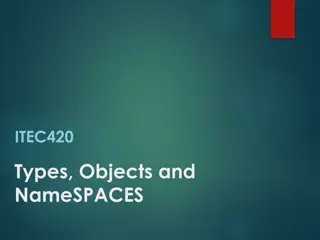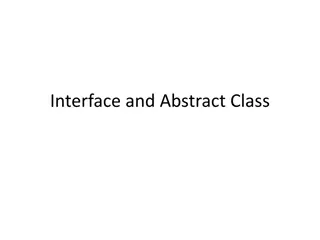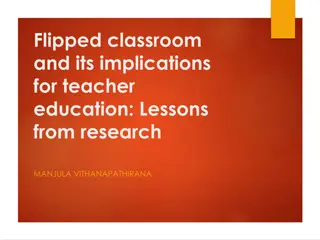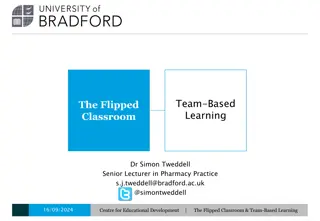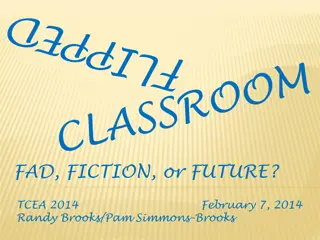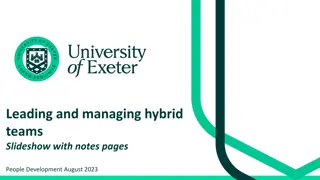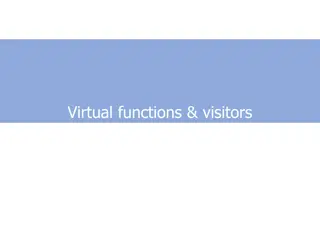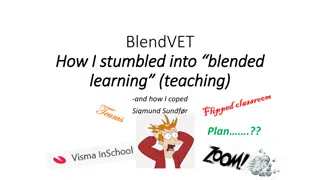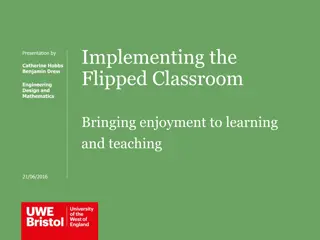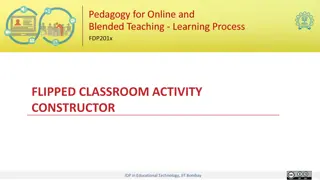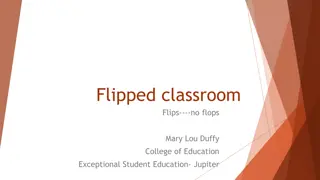
Teaching Strategies for Online, Hybrid, and Flipped Classes with Technology
Explore innovative teaching strategies for online, hybrid, and flipped classes with technology. Discover benefits, challenges, and effective communication tactics for engaging students in virtual learning environments while maximizing the advantages of flexibility and accessibility.
Download Presentation

Please find below an Image/Link to download the presentation.
The content on the website is provided AS IS for your information and personal use only. It may not be sold, licensed, or shared on other websites without obtaining consent from the author. If you encounter any issues during the download, it is possible that the publisher has removed the file from their server.
You are allowed to download the files provided on this website for personal or commercial use, subject to the condition that they are used lawfully. All files are the property of their respective owners.
The content on the website is provided AS IS for your information and personal use only. It may not be sold, licensed, or shared on other websites without obtaining consent from the author.
E N D
Presentation Transcript
Hybrid, online, and flipped classes: ideas for teaching with technology BEN LAABS AND TESSA HILL EARLY CAREER WORKSHOP FOR GEOSCIENCE FACULTY
Session goals Identify the benefits and challenges of online teaching Consider some communication and management strategies for your class Share ideas for active learning in an online environment
Online classes 1. What is your experience with online teaching and/or learning? 2. In previous classes you have taken or taught, what learning strategies were effective? What strategies were not? 3. What are your concerns about teaching online?
Definitions Synchronous learning live activities with instructor and all students Asynchronous learning activities completed on students own time Flipped class asynchronous lectures, active learning during class time Hybrid class blend of online and face-to-face teaching and learning
Some benefits of online teaching and learning Flexibility and convenience Accessibility Opportunities created by formalized asynchronous learning Higher enrollment, retention and student satisfaction #1. How would your students and you benefit from online teaching and learning?
Some challenges of online teaching and learning Preparation time Creative strategies for teaching, engagement, and assessment Structuring class and communicating expectations to students Managing communication Training students to use technology correctly #2. What specific challenge(s) do you anticipate for your online, flipped, or hybrid class?
Considerations and strategies Effective online teaching must include: The same learning outcomes and expectations as an in-person class A course schedule Instructor accessibility Opportunities for student engagement Formative and summative assessment
Considerations and strategies Assess your pedagogical readiness. Are you willing to: Use a variety of teaching techniques to engage students Recognize the differences between in-person and online teaching Include active learning and formative assessment in an online environment Manage asynchronous and synchronous learning activities Create a fully accessible course #3. List 2-3 specific differences between your online and in- person teaching.
Considerations and strategies Communication plan (for online and hybrid classes) Protocols for sharing course content, providing feedback, online interactions Should be clearly described in the syllabus Reiterate the plan early and implement it consistently Include a plan for synchronous and asynchronous activities
Considerations and strategies Communication plan should answer the following questions How will students be allowed to contact you? When and how can students expect a response to their inquiries? What type of feedback will students receive? How will announcements/reminders be communicated? How will you facilitate student-student interactions? #4. Write down a basic communication strategy for your class.
Considerations and strategies Management plan Set of strategies for handling online communication with and among students Synchronous communication etiquette is similar to a classroom Asynchronous communication management issues can arise
Considerations and strategies Management plan consider how you may handle the following Inactivity Dominant student(s) on discussion board or group project Digressions on discussion board or group project Common misconceptions displayed on assignments or quizzes Inappropriate comments #5. What communication management issues can you foresee for your class?
Considerations and strategies Strategy for dealing with common communications problems Inactivity give students credit for participation/asynchronous feedback Dominant student(s) encourage students early with step up or step back Digressions set clear expectations and provide feedback frequently Common misconceptions provide opportunities for self-assessment and correction Inappropriate comments set expectations for etiquette and respect, provide examples
Active learning and formative assessment Active learning Design activities that allow students to interact with you and one another Synchronous or asynchronous Allow students to self-evaluate and correct their work Formative assessment Quizzes and road checks Discussions and group work
Technology examples Slack Group communications, file sharing, announcements Blackboard Ultra Live presentations, virtual office hours Camtasia Recording lectures and demonstrations




